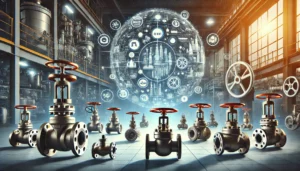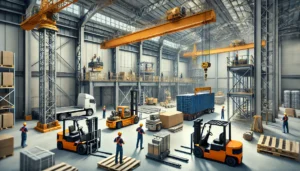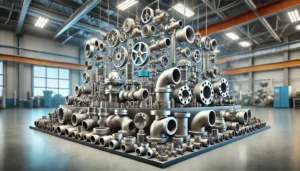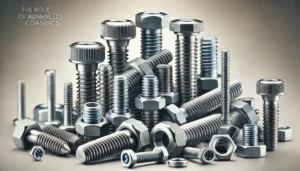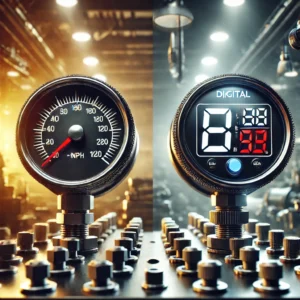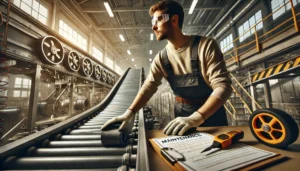Industrial belts, whether used for movement or material transmission, are fundamental parts of mechanical systems. These belts come in various types, each suited for particular applications and environments. To achieve the necessary efficiency, safety, and equipment longevity, an industrial belt must be selected carefully. This guide explores the different types of industrial belts and their uses in various industries.
1. V-Belts
Automobile engines, air conditioning systems, and conveyor systems all utilize v-belts, perhaps the most common type of industrial belt. They contain a trapezoidal cross-section which enables them to wedge themselves into grooves on pulleys. This unique design allows for the effective transmission of power. Slippage is common in high torque applications, but v-belts overcome this obstacle head-on. To meet operational demand, v-belts can be crafted from rubber or synthetic materials.
2. Flat Belts
Flat belts are loops of uniform cross-section which are made of flexible materials such as rubber or fabric. These belts are primarily used to transfer power between shafts or pulleys in machines operating at high speeds or over long distances. In the textile industry, flat belts are used widely where they power weaving or spinning machines. They are designed to operate silently, which makes them suitable for places where noise can be a problem. Furthermore, flat belts are multi-pulley capable, hence they are easily used in complex industrial systems which have intricate drive assignments.
3. Timing Belts
Timing belts, or sprocket belts, are belts with teeth that fit into corresponding lugs or grooves of the pulleys thus providing positive motion control between the parts. This design guarantees that slippage will not occur, thus removing the threat of inaccurate movements and power transmission. At places where timing accuracy is everything, such as automotive engines, robotics, and printing machines, timing belts are the unsung heroes. Their belts are of non-glossy neoprene or polyurethane and are fortified with fiberglass or steel cords for extra strength. Where maximum power and precision are fundamental, timing belts are the best.
4. Conveyor Belts
Belt conveyors are commonly used for transportation of materials or products throughout an entire system. They are essential in numerous industries like mining, manufacturing, and logistics. Some examples of belt conveyors and their applications include:
- Roller Bed Conveyor Belt: This belt has rollers underneath that support the weight of the material being transported. The materials can be moved without much friction, so it is easier to transport heavy objects. Roller bed conveyors are used most often in systems that sort and distribute packages.
- Flat Belt Conveyor: These are continuous belts that are shaped flat and made of different types of material such as rubber, PVC, or fabric. Belt conveyors of this type are very popular in construction assembly lines, packaging stations, and other places where small to medium sized items have to be moved.
- Modular Belt Conveyor: These are interlocking belts built from high durability and high flexibility plastic modules. These are used where the conveyor unit needs to change direction rapidly or where the conveyor unit has to climb or descend, e.g. in food cleaning and processing or materials handling.
- Steel Belt Conveyor: these are belts made of carbon or stainless steel. Such belts are used in industries with heavy duty applications such as automotive, machinery parts, component assembly, and food processing where high belt strength and durability are needed.
5. Round Belts
Round belts have circular profiles and are common in light duty activities. They can usually be found in small machineries or office machines where spatial limitations are present. Round belts are applied in the construction of printers, miniature conveyors, and some other specialized industrial machinery. Their uncomplicated construction allows for quick installation and replacement, which makes them an effective answer to a myriad of mechanical system problems. They are rugged and dependable because they can withstand moderately heavy loads and high speed operations.
6. Ribbed Belts
Ribbed belts, or poly-V belts, have along their length one or more ribs that run parallel to the sides of the belt. This construction enables the belt to provide compact size while having high power transmission. Ribbed belts find important uses in automobile industries where they are used to drive alternators, air conditioner compressors, and power steering units. These belts allow high speed operation with little vibration and are very effective in power transmission. With multiple ribs the chances of slippage and wear is reduced as the load is evenly distributed, therefore assisting in smoother operations.
7. Link Belts
Link belts consist of one or more segments that can be assembled to form a belt that properly fits the user. Apart from versatility, link belts are useful in situations where prompt replacements are necessary as parts can be assembled with a lot of ease. Mining, agriculture and heavy engineering manufacturing sectors commonly use link belts as they are reliable under severe working conditions. Link belts are able to withstand enormous strain, and their ease of assembly and disassembly renders them perfect for use in rigorous maintenance environments.
8. Steel Belts
Industrial carbon and stainless steel belts function optimally in conditions which require strong and long wearing capability. Cooking, conveying, drying, and many other processes in the food, chemical, and even mining industry utilize the benefits of these robust belts. In addition to this, steel belts retain and endure abrasion or extreme heat. While other belt types may not withstand extreme conditions, steel belts are the most ideal for heavy-duty work.
9. Elastic Belts
Elastic belts are made to stretch, and therefore, can adjust to various loads or tensions. These straps offer flexibility which makes them ideal in applications like gym equipment, certain light conveyor systems, and other home appliances that require elasticity. Elastic belts serve to absorb shocks and vibrations which reduces the strain on the machinery as well as prevents wearing and tearing. Their construction is often from rubber or polyurethane which gives it the ability to stretch and also recover back to its original shape.
10. Wire Belts
Woven metal wires on wire belts allow them to withstand extreme heat which makes them perfect for use in industrial ovens, dryers or any high temperature units. These belts serve to aid cooking, drying, material handling and a whole lot more in even the harshest environments. Owing to their durability and resistance to corrosion, wire belts are top of the line in the food processing, metalworking and automotive manufacturing industries. Even at high temperatures, they offer a strong, stable surface for moving products through different stages of production.
Conclusion
It is equally important to understand the different types of industrial belts as this will enable one to choose the right belt that fits the machinery’s requirements. Numerous factors, such as the nature of the application, load needs, operational conditions, and material to be conveyed, are significant in belt selection. Different types of belts, like V-belts, timing belts, steel belts, and wire belts, have basic strengths appropriate for particular uses. If these factors are taken into account, your machinery can operate properly, safely, and for a longer time, which will minimize maintenance and operational costs in the future.


